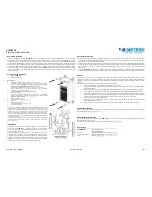
1. Read all safety precautions and follow L. B. White
recommendations when installing this heater. If
during the installation or relocating of the heater, you
suspect that a part is damaged or defective, call a
qualified service agency for repair or replacement.
2. Position the heater properly before use in accordance
with requirements for combustible clearances,
ground clearance, tilt angle, and to protect the
brooder from livestock. Refer to Fig. 2 as well as the
specification table on page 4 in this manual, for
information on installation and clearances.
3. Position the gas hose outside of the hot zone directly
above the heater to avoid any contact with the hot
canopy surface of the heater. Refer to Fig. 2.
4. Insure that all accessories that ship with the heater
have been removed from inside of the heater’s
shipping container and installed. This pertains to gas
hose, regulators, etc.
5. The heater’s gas regulator (with pressure relief valve)
should be installed outside of building. Any
regulators inside the buildings must be properly
vented to the outside. Local, state and national codes
always apply to regulator installation. Natural gas
regulators with a vent limiting device may be mounted
indoors without venting to outdoors.
6. Any regulator mounted outside the building be
protected against the weather, particularly ice
formation. Ice formation can lead to
overpressurization of the regulator and subsequent
gas leaks. See codes covering proper protection.
7. Always use pipe joint compound that is resistant to
liquefied petroleum gas and natural gas.
8. Check all connections for gas leaks using approved
gas leak detectors. Gas leak testing is performed as
follows:
-- Check all pipe connections, hose connections,
fittings and adapters upstream of the gas
control with approved gas leak detectors.
-- In the event a gas leak is detected, check the
components involved for cleanliness and
proper application of pipe compound before
further tightening.
-- Furthermore tighten the gas connections as
necessary to stop the leak.
-- After all connections are checked and any
leaks are stopped, turn on the main burner.
-- Stand clear while the main burner ignites to
prevent injury caused from hidden leaks that
could cause flashback.
-- With the main burner in operation, check all
connections, hose connections, fittings and
joints as well as the gas control valve inlet and
outlet connections with approved gas leak
detectors.
7
Installation Instructions
GENERAL
13. The grower shall inspect the heater before building
repopulation. Such inspection should consist of, but
is not limited to, the following points of action:
-- Insure proper clearance of heater to nearest
combustible materials.
-- Check for general cleanliness. Clean if necessary.
-- Check for tightness of the gas hose connections.
14. A qualified service person shall inspect the heater
and its gas train at least on an annual basis. This
should consist of, but is not limited to, the following
points of action:
-- Start-up and shut down of the heaters and zone
control panel to test for proper operation.
-- Leak check of all pipe joints and hose connections.
-- Thorough cleaning of the exterior of the heater, its
inlet venturi, combustion cones and filter (if
applicable).
-- Thorough inspection of the heater’s component
parts for corrosion, stripped threads, etc. with
subsequent parts replacement as necessary.
-- Gas pressure checks.
15. Turn off the gas supply when the heater is not in use.
WARNING
Fire aand EExplosion H
Hazard
■
Do not use open flame (matches, torches, candles,
etc.) in checking for gas leaks.
■
Use only approved leak detectors.
■
Failure to follow this warning can lead to fires or
explosions.
■
Fires or explosions can lead to property damage,
personal injury or death.








































